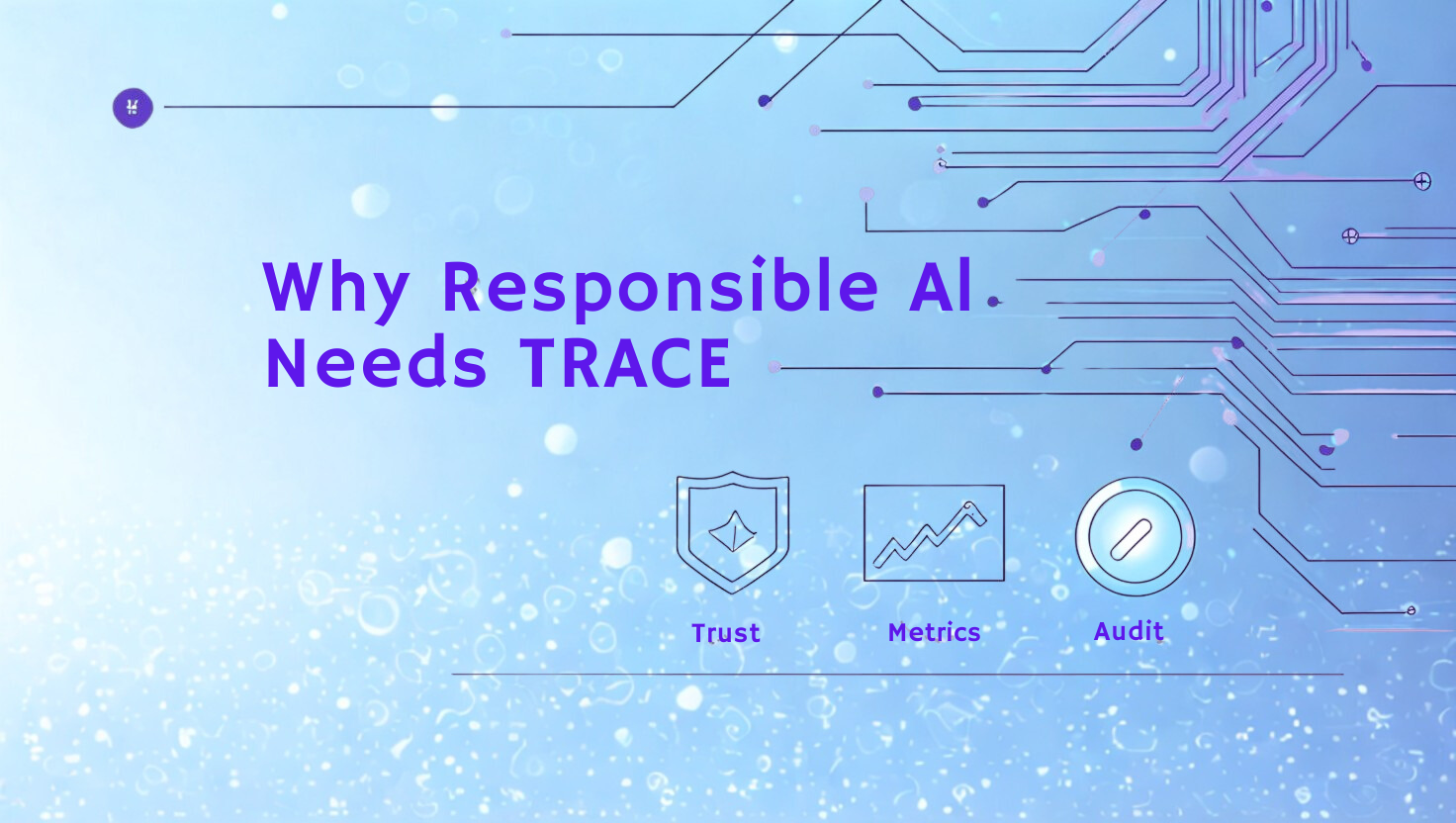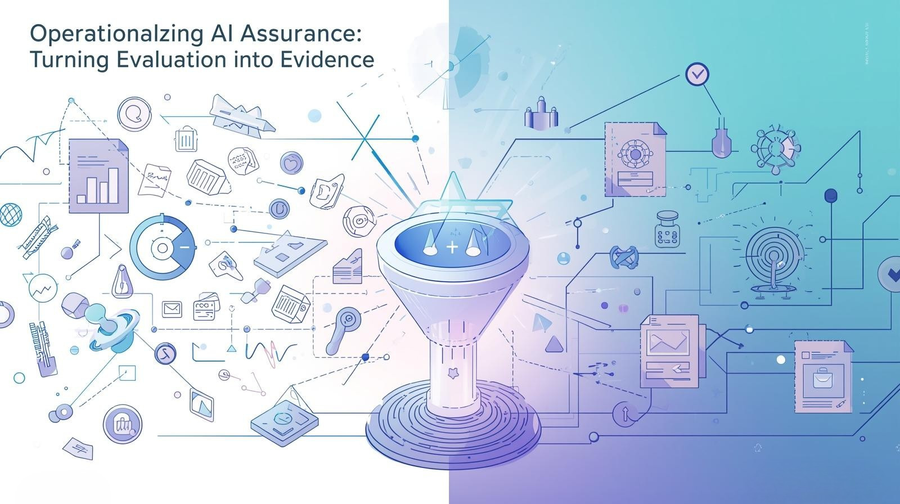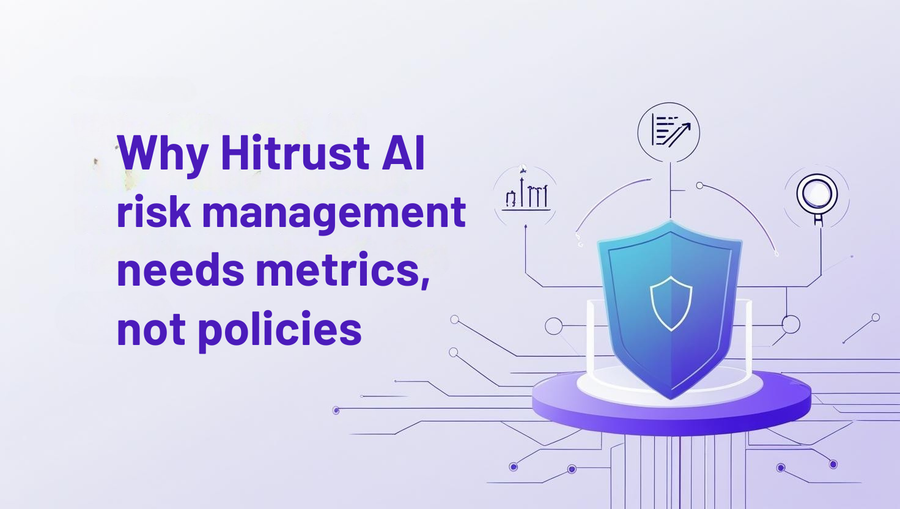AI now powers critical decisions in healthcare, finance, human resources, and the public sector. Yet most organizations still struggle to prove their systems are safe, fair, and compliant with emerging regulations.
The reason? AI governance today is often fragmented—built on disconnected evaluations, scattered policy documents, and static audits that don’t scale. This creates three persistent assurance gaps:
❌ No clause-aligned audit trail
❌ No deterministic link between metrics and controls
❌ No real-time assurance for buyers, regulators, or internal risk teams
With frameworks like the EU AI Act, NIST AI RMF, and ISO 42001 moving from recommendations to enforceable standards, intent alone is no longer enough.
Organizations must show verifiable execution—with traceable actions, measurable outcomes, and defensible evidence.
That’s exactly what TRACE delivers: an operational, transparent, and regulation-aligned framework for turning Responsible AI into provable practice.
What TRACE Is (and Is Not)
TRACE converts AI metrics into regulatory-grade evidence—without platform lock-in.
TRACE (Trust · Risk · Action · Compliance · Evidence) is a specification-driven assurance framework—not a proprietary black box.
It connects seamlessly with the evaluation tools you already use and deterministically transforms their outputs into:
- Risk classifications
- Governance actions
- Clause-linked, audit-ready evidence
TRACE brings structure, traceability, and regulatory alignment to Responsible AI—without requiring you to replace your existing workflows or tools.
Built on Open Standards and Regulatory Alignment
- Evaluation Plug-ins
Compatible with Fairlearn, AIF360, Evidently, OpenAI Evals, DeepEval, Giskard, AgentBench, ARC red-team libraries, and other custom probes via a lightweight Metrics API. - Data & Policy Formats
Uses JSON/YAML configurations, JSON Schema for metrics, Open Telemetry for traceability, SPDX for licensing, and OPA/Rego for policy logic—ensuring transparency and interoperability. - Immutability
Every run is anchored using SHA-256 hash chains, creating tamper-evident records suitable for audit trails and lifecycle assurance. - Built-In Regulatory Alignment
All thresholds, control flows, and clause mappings are version-controlled and aligned with leading frameworks—including the EU AI Act, NIST AI RMF, ISO 42001, and GDPR.
This ensures that every decision and action is traceable to real-world legal obligations—not just internal policy.
TRACE : Turning Metrics into Proof
| Pillar | Governing question | Governance deliverable |
|---|---|---|
| Trust | How reliable is the raw signal? | Canonical metric + provenance metadata |
| Risk | How severe is the exposure in context? | Residual-risk bucket (Low / Elevated / Unacceptable) |
| Action | What control must be invoked? | SLA-bound control template + action graph |
| Compliance | Which statutory clause is covered? | Real-time clause-coverage ledger |
| Evidence | Can an auditor verify independently? | Cryptographically sealed Assurance Envelope |
Each evaluation metric traverses these pillars in a closed loop, turning numbers into proof.
Foundational Design Principles — Built for Rigour, Designed for Flexibility
TRACE is grounded in seven core principles that ensure Responsible AI governance is not only robust and transparent, but also scalable across diverse use cases and evolving regulatory landscapes:
- Canonicalisation
Every metric is assigned a globally unique identifier to eliminate ambiguity and prevent semantic drift across teams, models, or versions. - Contextuality
Thresholds are not static. They adapt dynamically based on use case, industry criticality, and regulatory classification—ensuring scoring logic reflects real-world risk. - Measure-to-Manage Coupling
Evaluation doesn’t stop at insight. Each residual risk level deterministically triggers an assigned control action, closing the loop between detection and remediation. - Clause-First Assurance
Compliance is built-in, not bolted on. Every control is embedded with explicit legal clause references at design time, enabling real-time regulatory alignment. - Immutability
All key elements—metrics, risk scores, controls, and legal mappings—are cryptographically hash-linked, creating an audit trail that is tamper-proof and independently verifiable. - Bidirectional Traceability
Navigate both top-down from policy to technical evidence, and bottom-up from model output to clause compliance—ensuring transparency for regulators, auditors, and engineers alike. - Pillar-Aware Design
Every metric is multi-tagged across TRACE’s Responsible-AI (RAI) Governance Pillars (Performance, Fairness & Bias, Task Adherence, Reliability, Safety & Truthfulness, Robustness, Privacy), enabling structured reasoning and composite scoring across assurance domains.
These principles make TRACE not just a governance overlay—but a foundation for building trustworthy, defensible, and scalable AI systems.
How the Assurance Loop Works — Step by Step
TRACE transforms raw evaluation signals into clause-linked, audit-ready assurance in real time. Here’s how a single metric travels through the Assurance Loop:
- Metric Ingest
An evaluation result—e.g.,Gen_HallucinationRate = 1.8%for a hospital chatbot—is submitted viaPOST /v1/metricsto the TRACE Metrics API. - Contextual Thresholds
TRACE applies domain-specific thresholds:
1.8% may be Low risk in retail settings but is flagged as Elevated in healthcare due to higher criticality and regulatory expectations. - Risk Classification
Based on this context, TRACE classifies the residual risk as Elevated, triggering downstream governance logic. - Control Invocation
A pre-configured control—“Enable grounding with enterprise knowledge base”—is automatically queued with a 24-hour SLA. The action includes named owners, rollback instructions, and escalation paths. - Clause Mapping
The invoked control is linked to EU AI Act Article 15 (accuracy, robustness, and cybersecurity). TRACE updates its clause ledger and assurance dashboard in real time. - Evidence Package
The full path—metric → risk → control → clause—is cryptographically sealed into an immutable Assurance Envelope, anchored on a ledger for independent verification.
Total time: Less than 90 seconds from initial risk detection to clause-aligned, audit-ready evidence.
(As validated in the healthcare POC scenario.)
TRACE-RAI Scorecard — From Raw Metrics to Boardroom Insight
The TRACE-RAI Scorecard distills complex evaluation outputs into a single, interpretable view—built for governance stakeholders, not just data scientists.
TRACE aggregates scores across its seven Responsible-AI governance pillars (Performance, Fairness & Bias, Task Adherence, Reliability, Safety & Truthfulness, Robustness, Privacy) and renders them as a 0–100 Responsible AI Index, visualized through a dynamic seven-spoke radar chart.
This chart provides a fast, intuitive snapshot of your model’s assurance posture—ideal for regulatory reporting, executive dashboards, and boardroom briefings.
Behind the scenes:
- ROC-based thresholding defines red/yellow/green zones using statistically grounded benchmarks (e.g., disparate impact ≤ 0.80)
- Industry-specific YAML configs allow teams to adapt thresholds to context—e.g., a bank may flag fairness gaps above 7% as critical, while a media company might only trigger controls at 10%
The result: a scorecard that’s not just visual, but actionable, defensible, and tailored to your risk tolerance.
Controls & Orchestration — From Alert to Remediation
TRACE doesn’t just flag risk—it acts on it, using a rules-based orchestration engine designed for real-world governance.
Every control within TRACE is classified according to COSO’s control taxonomy—Preventive, Detective, Corrective, or Compensating—and dynamically assigned based on the severity of residual risk through a Risk-Weighted Orchestrator.
For example, if a model crosses an Unacceptable toxicity threshold, TRACE can automatically trigger a “kill-switch” workflow—such as halting the model, revoking access, or switching to a safe fallback—within 60 seconds.
Each control is:
- Bound to an SLA, with clear ownership
- Traceable to its trigger condition and clause coverage
- Logged with a before/after effectiveness delta, enabling continuous improvement
This approach satisfies ISO 31000’s “monitor and review” principle and EU AI Act Article 9, which mandates lifecycle-based risk management.
TRACE transforms compliance from a checkbox exercise into a proactive and responsive control system.
Comparative Fit with Major Frameworks
| Framework | How TRACE Contributes |
|---|---|
| NIST AI RMF | Automates the Measure → Manage transition with deterministic, clause-linked controls. |
| ISO 42001 | Generates machine-readable artefacts that populate AI management system clauses. |
| EU AI Act | Provides real-time dashboards and sealed evidence aligned with Article 10 (data governance) and Article 15 (robustness). |
| GDPR Article 25 | Operationalises privacy-by-design by embedding data protection controls directly into model workflows. |
TRACE doesn’t just align with these frameworks—it operationalizes them through transparent logic, automated control flows, and audit-ready evidence.
Documented Benefits — Measurable Gains Across the AI Lifecycle
TRACE delivers not only governance clarity, but tangible operational advantages. By automating risk evaluation, control orchestration, and compliance evidence, organisations see measurable improvements across audit, sales, and incident management workflows.
| Outcome | Typical Improvement |
|---|---|
| Audit Preparation | 60% reduction in time through clause-aligned automation |
| Enterprise Sales Cycle | 30–40% faster deals by providing verifiable AI assurance |
| Incident Response | < 90 seconds from risk signal to documented control |
| Manual Tracking Overhead | Eliminated via real-time dashboards and automated logs |
| Regulator & Customer Confidence | Significantly increased with traceable, clause-linked proof |
TRACE turns compliance from a reactive burden into a proactive business enabler—speeding up trust-building with both customers and regulators.
From Intent to Evidence — Making Responsible AI Real
TRACE transforms Responsible AI from high-level principles into provable, repeatable, and defensible practice.
By fusing open-source evaluations, context-aware risk logic, and cryptographically sealed evidence into a unified assurance flow, TRACE ensures that every model decision—every metric, control, and clause—is transparent, traceable, and auditable.
You don’t need to overhaul your stack or buy into a proprietary black box. TRACE integrates with the tools you already trust, aligning technical evaluations with regulatory demands—automatically.
Deploy confidently. Defend with evidence. Scale responsibly.
That’s the promise of TRACE: operational assurance you can prove.






